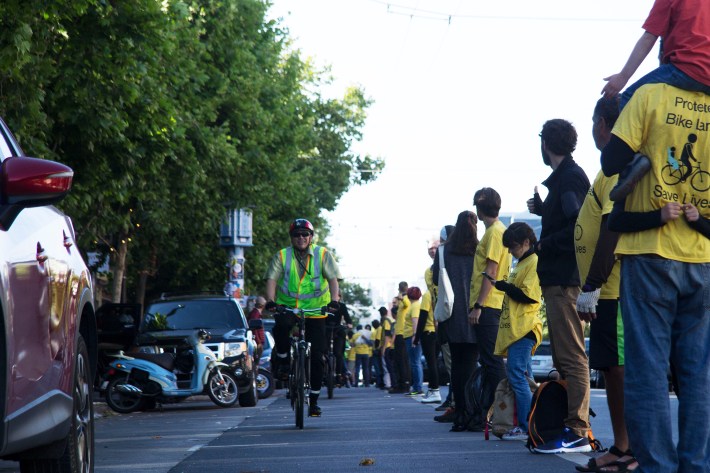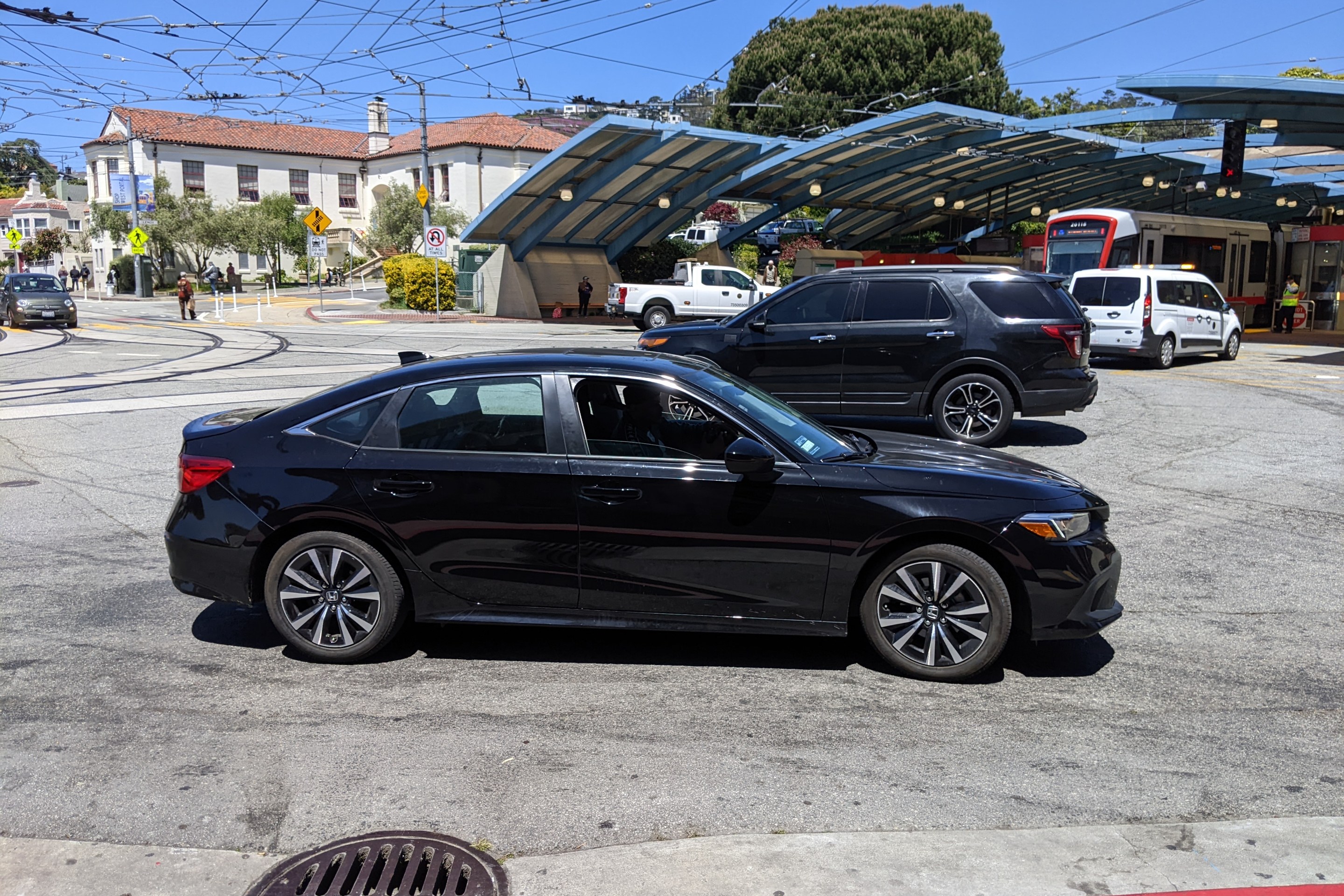Guest Commentary: Enough Delays, Valencia Street Needs a Protected Bike Lane This Year
3:44 PM PDT on September 6, 2018

A rendering of a quick, fast, low budget, interim solution for Valencia, made by advocates
Bill Couch was riding his bike on Valencia Street, between 21st and 22nd, early on the morning of Tuesday, August 21, when he was struck by a hit-and-run driver. "I fractured seven vertebrae, broke two ribs, my left thumb, and underwent a severe concussion," he posted on Twitter a week after the crash, adding that he is, thankfully, expected to make a full recovery.
Couch is just the latest cyclist to be seriously injured riding on this street.
Ten years ago, SFMTA had already recognized Valencia Street as the second-most dangerous street (behind Market) for people on bicycles. It is part of the city's "High Injury Network." Every day there are over 2,000 bike trips on Valencia. That’s over 700,000 times per year that our residents risk their lives biking on this street. A decade of inaction from SFMTA is inexcusable. The agency has started a plan to fix the street, thanks to repeated demonstrations and intense lobbying from bicycle advocates. But it still has no timeline for putting in protected bike lanes. The city has to do better. It has to install a protected bike lane on the majority of Valencia this year--yes, within the next four months.
Last Tuesday morning, I was the victim of a hit and run on my bike. I fractured 7 vertebrae, broke 2 ribs, my left thumb, and underwent a severe concussion, but will make a full recovery. The support from friends, family, and coworkers has been bewildering. Thank you all so much. https://t.co/wqEqK8OjyA
— Bill Couch (@couch) August 29, 2018
Valencia Street 2008 - March 2018
In the past ten years, SFMTA has added a jug-handle bicycle turn from Market to Valencia, a green bike box at Duboce, and one block of parking-protected bike lane on the southernmost end of Valencia. This is woefully inadequate. Between 2012 and 2016 there were 268 reported collisions on Valencia: 107 of those--forty percent--were car/bicycle collisions.
Summer 2017: People Protected demonstrators and Supervisors push for action
SFMTA didn't start plans for protected bike lanes on all of Valencia until People Protected Bike Lane demonstrations started last year. After two successful demonstrations, then-Supervisor Sheehy unlocked $145,000 of funding through SFCTA to immediately begin planning for near- and long-term improvements.
Yet SFMTA still has no public timeline to provide protected bike lanes on the majority of the street, including the block where Couch was nearly killed. In March of this year, after SFMTA painted an additional white line and placed some soft-hit posts at some parklets on Valencia, Jamie Parks, SFMTA’s Livable Streets Acting Director, sent out a tweet promising “continual, incremental changes rather than [waiting for one] perfect (and inevitably long-term) project.” Street safety advocates cheered this announcement. However, July’s community meetings made it clear that SFMTA isn't following through on this promise.
Trying to move toward model of continual, incremental changes rather than wait for 1 perfect (and inevitably long-term) project
— Jamie Parks (@transpocrat) March 10, 2018
Summer 2018: SFMTA prioritizes car parking over bicyclist safety
The agency continues to prioritize loading zones and parking over protected bike lanes. Curb changes are expected to take place on all of Valencia Street by early 2019; however, the current plan will test protected bike lanes on only three of Valencia Street’s fifteen blocks by the end of 2019. Does Valencia need curb changes? Yes, but bicycle safety activists didn’t put their bodies on the line during the People Protected Bike Lane demonstrations so ride-hail companies and delivery services could have better curb access. SFMTA’s top priority for the Valencia Bikeway Project needs to be a near-term protected bike lane.
As SFMTA has shown on the Folsom Street Safety Project, near-term parking-protected bike lanes can be implemented before the design of a long-term bike lane is complete.
Eleven of the fifteen blocks of Valencia have a ten-foot center turn lane. By removing this center turn lane, SFMTA will have enough room to flip the bike and parking lanes and install a five-foot buffer of paint and soft-hit posts between the two. This has become standard procedure on streets throughout SOMA - 7th, 8th, Folsom, Howard, etc. Valencia's bike lane doesn’t need to be piloted - it simply needs to be installed.
A parking-protected bike lane is easy and cheap to install and can be updated or improved at any point in the future. These eleven blocks of Valencia Street have neither bus stops nor overhead Muni wires, which should simplify installation even further. This improvement would not be a perfect protected bike lane, but it would provide a substantial improvement to 75 percent of Valencia--adding 1.4 miles of protected lanes in each direction. This is the type of incremental and continual change I assumed that Jamie Parks was referring to in his March tweet.

Instead, the SFMTA community meetings were entirely focused on the long-term design of protected bike lanes on Valencia. Diagrams were presented of center-running, two-way side-running, and traditional parking-protected bike lanes. SFMTA has been doing a good job of proposing new versions of protected bike lanes and asking for feedback. However, this should not be allowed to hold up the immediate installation of protected bike lanes.
SFMTA needs to separate the bicycle safety project into independent, manageable parts
Here’s how I would separate and, most importantly, prioritize the improvements to Valencia Street:
- Parking-protected bike lanes from Market to 15th and 19th to Mission. This change would only cost a few hundred thousand dollars and could be implemented within months.
- Curb and loading zone changes. Right now delivery services and ride-hail companies have two bike lanes and a center turn lane to utilize as loading. Once the center turn lane is removed and the bike lanes are protected, loading will become an issue and should be fixed quickly.
- Protected bike lanes from 15th to 19th. It is more challenging to install protected bike lanes along this stretch because it has wider sidewalks and no center turn lane to repurpose. The block between 16th and 17th streets also has overheard Muni wires, which may have to be moved based on which design is chosen for this stretch.
- Long-term protected bike lanes from Market to 15th and 19th to Mission. These protected bike lanes should then be revisited to incorporate protected intersections and potentially a different design (two-way curbside or center-running) depending on the preferred design for the section of 15th to 19th.
- Vehicle restrictions on Valencia. SFMTA dismissed potential vehicle restrictions too quickly. Guerrero, Van Ness, and Dolores should handle through car traffic, not Valencia. Valencia should not have a motor-vehicle turn pocket from Market. However, coupled with Mission Street vehicle restrictions, these changes could have wider impacts and should be piloted and studied before full implementation. This will take time.
- Shopping districts between 16th and 17th Streets and 23rd and 24th Streets. The Bicycle Advisory Committee recently passed a resolution to support these shopping districts that would open two blocks of Valencia to people walking and biking. It’s bold and should be pursued by SFMTA.
Together these crucial changes create a bold vision for the future of Valencia Street that would serve as a model for the rest of San Francisco and the country. Imperfect, continual improvements to Valencia Street over the next five to ten years would surely annoy some stakeholders--bicyclists upset about mixing-zone intersections, delivery people upset about losing bike lanes for loading, etc. Therefore, we cannot expect SFMTA to deliver these bold changes without political cover and leadership from our elected officials. Supervisors Rafael Mandelman and Hillary Ronen must champion a new vision for Valencia designed for people, not cars. In addition, Mayor Breed must also step up and explicitly call for a fast implementation of Valencia’s protected bike lane. SFMTA has already squandered a decade since realizing how dangerous Valencia is. We’ve put our bodies on the line enough. Now we need SFMTA to replace that people-protected bike lane with real protection. The agency needs to install protected bike lanes this year. Yes, within four months. And, yes, they can do it if directed by our Mayor and Supervisors.
Kyle Grochmal is a San Francisco street and bicycle safety advocate who is active with People Protected Bike Lanes. He works full-time at a technology company and frequently posts on Twitter @KCGrock.
Stay in touch
Sign up for our free newsletter
More from Streetsblog San Francisco
Supervisor Melgar Betrays Promises, Sells Out Family Killed in West Portal
Well that didn't take long




